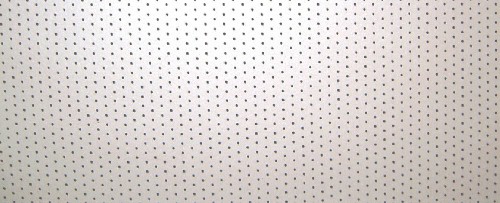The Cinema Screen
========================================
Cinema screens are never given much thought by the cinema customer
They only realise that there is a screen if it is dirty, or the film breaks
After all, they appear to be very simple, just a large white sheet that the film is projected onto, but they are a very important part of the projection chain
There is a large amount of technology in their design and installation
A screen is normally constructed of vinyl panels, and is known by the amount of light that it reflects back to the viewer
For a start very few screens are solid
Most have a great many small holes in them to let the sound through from the speakers mounted behind them
Click on photo to return
Photo of holes in screen over a 12 inch length
Click on photo to return
There are four main categories:
Matte White that reflect about 5% of the projected light
Pearl that reflect about 15% of the projected light.
Silver that reflect about 30% of the projected light
Glass beaded that reflect about 40% of the projected light
(Considering the small reflective amounts, plus the 25% of light lost on the projection porthole glass, it is a wonder that any light is seen by the audience at all. This proves the efficiency of the arc lamp, and projector optics)
Matte White is normally used only in smaller theatres of under 100 seats
Pearl & Silver are the two most common types used
Glass beaded is normally too bright, and only used in very special circumstances
To make the common Pearl or Silver screens a reflective coating is sprayed over a matte white surface
Glass beaded screens have thousands of glass beads embedded into the surface
Behind the screen there are usually three sets of loudspeakers, left - centre- right
The audio comes through the appropriate speaker
If a person is speaking on the right of the picture then their voice should come through the screen on that side
The same applies to the centre, and left speakers
There are also loudspeakers located around the auditorium. These are called Effects, Surround, or Ambience speakers, but are outside the scope of this web page
The curve of the screen also has to be taken in consideration
These are:-
Flat screen
Horizontal curved screen
Horizontal & vertical curved screen
A flat screen is just as it says, and is usually only used in small auditoria
When used in larger theatres a pin cushion effect,** and light fall off, especially noticeable to people sitting away from the centre of the row of seats, can be observed
** Where vertical lines at the edge of the picture bow inwards like this ) (
This effect is caused by the difference distance that the light from the projector has to travel
Light travels a shorter distance to the centre of the screen than to the edges
This makes the picture slightly larger towards the edges of the screen
By placing a curve in the screen the light now travels the same distance to all parts of the screen, and does not distort the picture
A screen can also curve in a horizontal & vertical direction
This is normally only used for very large screen projection, or special projection techniques
